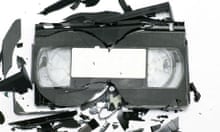A virulent infection is destroying the audio and videotapes once used to capture important moments of family life and great historic events. The fungal blight, or 'tape mould', has already ruined thousands of miles of audio and video tape in Britain and, according to specialist restorers, much more is likely to be deteriorating, unobserved, in storage. The infection of VHS cassettes and of the audio cassettes popular in the 1980s and 1990s is increasing at an alarming rate.
'We used to get around one or two cases a year, and now about 10 per cent of all the work that is sent to us is mouldy. But sadly there is nothing we can do about it here,' said Chris Frear, who runs a restoration business in Scotland.
The wet summers of the last three years have taken the problem to epidemic proportions.
'It has got to the stage that we open up all the packages of tapes we are sent in a separate room, away from our playing equipment and then we wash and disinfect our hands, because it is so contagious. If it got on to the tape heads in our machines, it would spread everywhere. It's almost like the measles.'
Tapes of family footage stored inside cardboard boxes in damp domestic cellars or lofts are at particular risk, but curators of larger private and public archives are also often unaware that damp conditions or temperature variations can allow one infected item to decimate an entire collection.
'We do see tapes with fungal growth, and if we catch it early enough we can often save the recording,' said Nigel Bewley, head sound engineer at the British Library Sound Archive in London. 'We use a quarantine room and send mouldy tape away to be sterilised first, often through a process of irradiation. The danger is that live spores could reach the rest of our collection.'
Video and audio tape is made from cellulose coated with ferric oxide, but, just like the sticky tape on an old parcel, it dries out and becomes brittle with age. Modern techniques can combat this ageing process, allowing the tapes to be digitally copied, but mould that has eaten into a tape is defeating conservationists. Typically tapes with the fatal fungus look as if they are covered with a fine white dust.
'Mould is a much more serious thing than snapped or worn tapes, and it's heartbreaking to have to ring up a customer who was so thrilled to have at last found a missing tape, just to tell them its unplayable,' said Beth Frear, who works with her son in their family business, Precious Voices, based in Dumfries and Galloway.
'A typical museum collection is just boxes on a shelf or in an ill-ventilated store cupboard. Few curators realise the material is degrading all the time and think that it will keep until some miraculous budget bonus will allow them to digitise it,' said Frear.
Yet the value of preserving personal recordings may be impossible to estimate. 'It's hard to pick out special examples - but there was a gentleman in the British diplomatic service who had been under siege in his residence during the partition of Pakistan into the present Pakistan and Bangladesh. Each day he had rung around his British friends to see if they were still alive and recorded their phone conversations on his reel-to-reel machine. It's all terribly stiff upper-lipped, but there, blow by blow, is a daily account of who was attacked and who had been mortared in the previous 24 hours.'
The Frears have rescued many aural histories, including the account of the life of a stallion walker who led a shire stallion from farm to farm to breed the horses for ploughing and a recording of a Scottish kippering girl who tells of her gruelling work in the 1870s and 1880s, following the herring fleet as it moved south each year from Aberdeen to Lowestoft.
'Just in the last few days we had our first birth recording,' said Frear. 'It was taped in Brazil in the 1960s and is a blow by blow account of the journey to hospital, the birth of the baby and its first cries.'
The British Library Sound Archive advises that all stored tapes, audio, visual and computer, should be kept in the dark, away from heat sources and with no extreme temperature fluctuations.
Save your souvenirs
VHS and audio tape should not be stored in:
· garden sheds
· lofts, cellars or anywhere where the temperature fluctuates
Tapes should be kept:
· in the dark
· away from direct heat sources
· labelled in a cool cupboard that is heated during the winter
How to deal with tape mould
· Look for a fine white dust
· Don't blow it away across the rest of your collection
· Don't play the damaged tape (you could infect the machine)
· Don't throw away mouldy cardboard casings or surrounding storage boxes without noting down the details of the recording, such as the date, location and names
· Do not place near other newer tapes
· Wash your hands thoroughly after touching infected tape
· Send partially damaged tapes for professional sterilisation (either through irradiation or in an oxygen vacuum). The dead spores can then be delicately brushed away. The tape should be cleaned with swansdown, which is a lint-free cloth



